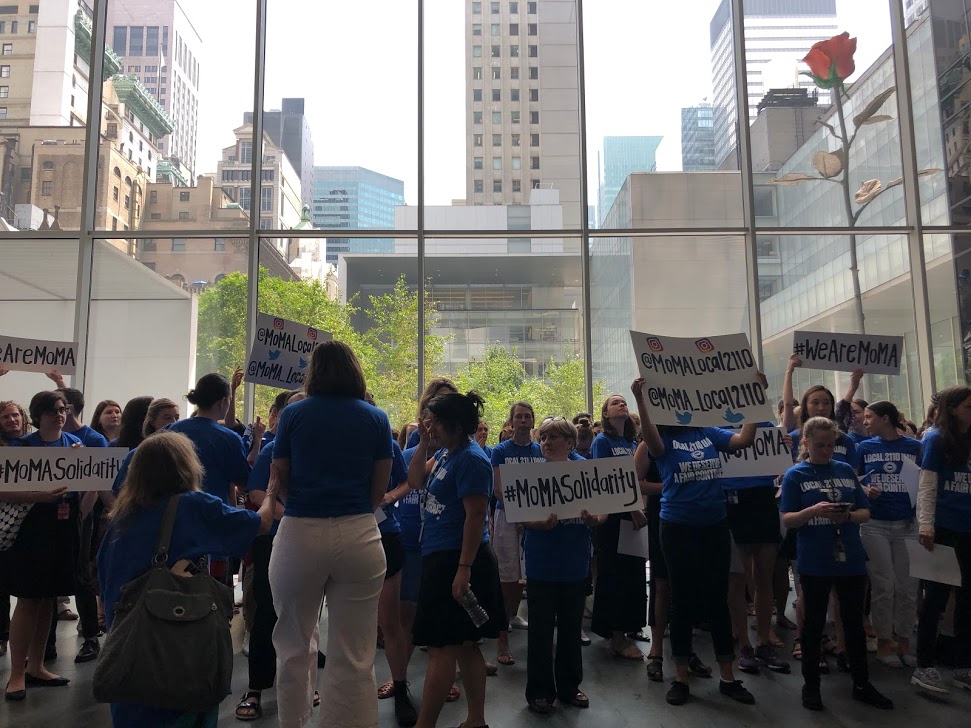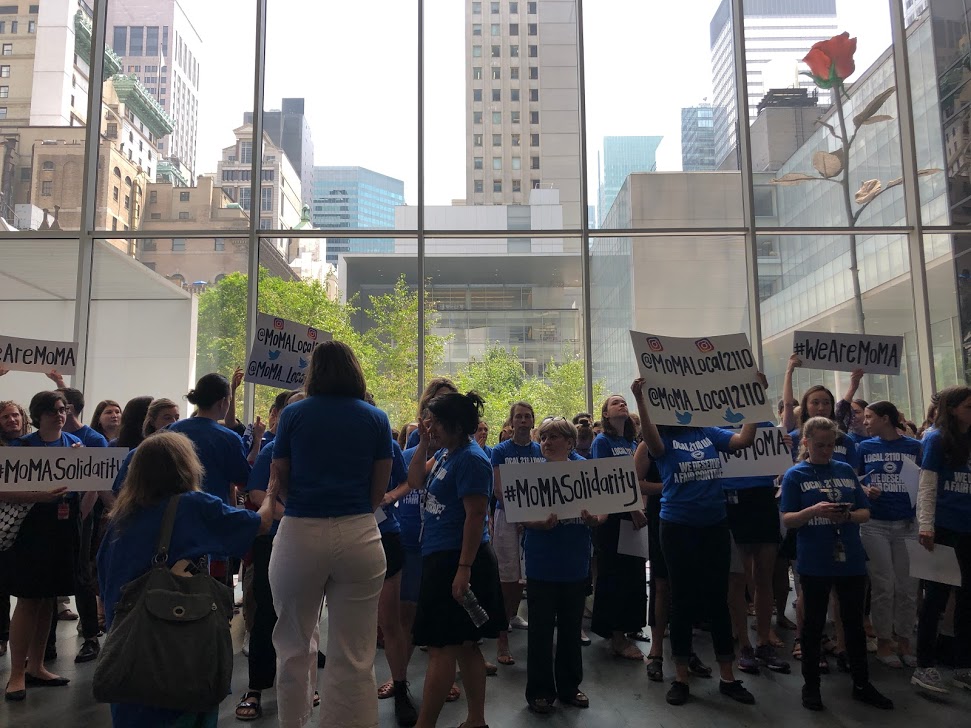[ad_1]

A protest at the Museum of Modern Art led in 2018 by Local 2110.
ANDREW RUSSETH/ARTNEWS
As the Museum of Modern Art opens in a reimagined fashion in New York, ARTnews looks back upon some notable happenings from the institution’s history in a series of reminiscences of storied “MoMA Lore.”
Amid ongoing calls for more transparency within institutions of all kinds, workers at an array of New York enterprises including the New Museum and Guggenheim Museum have formed much-publicized unions of late. It’s possible that these workers’ groups might not exist if not for the formation of a union more than 50 years ago at the Museum of Modern Art. That organization—the Professional and Administrative Staff of the Museum of Modern Art, or PASTA for short—was formed in 1971 and has advocated for improved wage structures and new health care plans. All the while, it has remained one of the leading groups demanding rights and transparency for art workers in New York.
PASTA, which also goes by the name MoMA Local 2110 (and now counts as one of several unions representing workers at the Museum), has its roots in tense times in the late 1960s and early 1970s when groups such as the Art Workers’ Coalition and the Black Emergency Cultural Coalition began advocating for political change at MoMA, the Whitney Museum, the Metropolitan Museum of Art, and other institutions. (One memorable AWC slogan was “ART WORKERS DON’T KISS ASS.”) PASTA’s first strike came the year it was formed, and when the New York Times reported on it—in an article headlined “MOMA Gets a Taste of PASTA”—the paper identified the union as the first workers’ group of its kind.
After getting its contract ratified, PASTA led a second strike in 1973 that was larger and louder—and viewed as a watershed moment within the art world. Artforum put an image from the strike on its cover, and in an interview in the issue, an unidentified PASTA member told critics Lawrence Alloway and John Coplans, “The reason this union exists is because the museum was very badly managed.” (At the time, the union member said, around 170 staff members of the 400 working at the institution were part of PASTA.)
Though there were other protests amid contract negotiations, there wasn’t another major PASTA strike until 2000, when 250 employees led a walkout that lasted 134 days. That time, the cause was concern that the museum had prioritized a $650 million expansion over giving employees what members thought would be fair pay, and the walkout led the museum to cancel fundraisers, screenings, and concerts. Though the union was forced to make concessions on its health-care demands, it got MoMA to offer its workers a new wage structure—and the spirit of that strike continues to shape the mentality of art workers in New York today.
ARTnews reached out to art workers’ rights experts to learn more about the legacy of PASTA. —Alex Greenberger
Julia Bryan-Wilson
Art historian and author of Art Workers: Radical Practice in the Vietnam War Era (University of California Press, 2009)
In the 1970s, there was a lot of organizing energy to pressure the museum to recognize that the people who worked there were workers—they weren’t meant to sacrifice their workplace conditions because they were brushed with a special imprimatur of an elite cultural institution. That pressure was coming from all different quarters, and not only because there was an active union movement. A lot of the people on the front lines were women who were involved in the women’s liberation movement, and there was a really strong sense that oppression was coming from all sides. There was a sense of urgency about how they needed to take matters into their hands and come together as a collective voice.
As a symbolic entity, MoMA still looms so large in the art-world consciousness. It takes a cultural leadership position, so any time it makes a big shift, that’s going to resonate. There were other organizations having conversations about unionizing around the time that PASTA did, but PASTA became the most visible group because MoMA is so visible. It was partly because MoMA was in New York but also because it had a high-profile board that then, like now, was under attack. There was a sense that these concerns were all interlocking. Those same questions about board accountability, the military-industrial complex and museums’ imbrication in [such] systems, racial justice, gender justice—those are all on the agenda [now].
Art + Museum Transparency
Activist group, organization behind recent “Art/Museum Salary Transparency 2019” online spreadsheet
We’ve always found PASTA to be a great example of how a social and political movement like the Art Workers’ Coalition could transform a union drive. It’s about how what a museum does in its public-facing work relates to what it does in the workplace. That’s something that museum workers struggle with a lot—trying to build those connections. Our sense is that, with the current unions being formed, they’re aware of this context.
Institutional critique and protests within the art world [during the ’70s] were happening during a moment of foment. It grew out of the antiwar movement, and there’s so many parallels to the current moment. So many of the Art Workers’ Coalition’s demands had to do with board members and their support for the war machine. This is a process we’ve gone through before—it’s not some insane demands that young people are making. There’s a history of holding museums accountable.
One of the stranger things about the MoMA union drive is that it didn’t start a domino effect. MoMA sucks up so much oxygen in the museum space and is seen as this national lodestar. Because of MoMA’s exceptionalism, [the formation of PASTA] was not taken as a model for other museums. It’s a shame that it wasn’t able to start a mass movement. We’re hoping that, with this current moment, we can keep up momentum.
Dana Kopel
Member of New Museum Union organizing committee
I was put in touch with Maida Rosenstein, who runs Local 2110, and some people in the union at MoMA, and that was a really big factor for our unionizing—seeing the salaries at MoMA and hearing from people who worked there about how the union has positively impacted them. They gave out a list of bargaining unit salaries, and they were so inconceivably higher than ours. Our health-care contributions were pretty high, and theirs were pretty low to nonexistent for single employees. That was revelatory—to see not only what a union is but what it means to have a union over time.
When we authorized the vote to strike [this past September], we were talking a lot about the MoMA strike in 2000. That was the last major strike in the New York art world that I’m aware of, and we were thinking about our move in relation to it. Their strike lasted four months, but they got so much out of it. That was when MoMA went from an open shop to a closed shop [through which the museum gives priority in the hiring process to people already belonging to the union], and that was a huge deal. That was encouraging when thinking about authorizing a strike, which can be really scary but also really powerful.
In a basic way, when things like [the formation of the MoMA union] happen, it shifts the realm of possibility. I think we’ve seen that with the New Museum Union more recently, and MoMA’s union was a huge factor. It’s a reminder that, despite the art world’s emphasis on individualism and the difficulties of building solidarity among art workers, this had been possible—so it could be possible again.
[ad_2]
Source link

